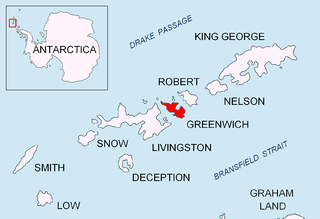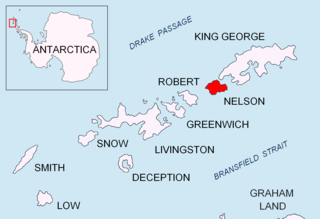
The Dailey Islands are a group of small volcanic islands lying off the coast of Victoria Land, 9 kilometres (5 nmi) northeast of Cape Chocolate, in the northern part of the ice shelf bordering McMurdo Sound. They were discovered by the British National Antarctic Expedition, 1901–04, under Robert Falcon Scott, and named for Fred E. Dailey, the expedition carpenter.

The Windmill Islands are an Antarctic group of rocky islands and rocks about 11.1 kilometres (6 nmi) wide, paralleling the coast of Wilkes Land for 31.5 kilometres (17 nmi) immediately north of Vanderford Glacier along the east side of Vincennes Bay. Kirkby Shoal is a small shoal area with depths of less than 18 metres (59 ft) extending about 140 metres (459 ft) westwards and SSW, about 3.4 kilometres (2.1 mi) from the summit of Shirley Island, Windmill Islands, and 0.24 kilometres (0.15 mi) NW of Stonehocker Point, Clark Peninsula.

The Ibar Rocks are two rocks located 0.4 kilometres (0.2 nmi) east of Bonert Rock and 1 kilometre (0.6 nmi) southeast of Canto Point, Greenwich Island, in the South Shetland Islands. The names "Islote Ibar" and "Islote Teniente Ibar" appearing on Chilean hydrographic charts in the 1950s refer to the larger and western rock. The recommended name "Ibar Rocks" includes a submerged outlier to the northeast of the larger rock. Teniente (lieutenant) Mario Ibar P. signed the official act of inauguration of the Chilean Captain Arturo Prat Base on Greenwich Island in 1947.

Bizeux Rock is a rocky island 0.2 kilometres (0.1 nmi) long lying 0.2 kilometres (0.1 nmi) east of Manchot Island and close northeast of Cape Margerie. It was charted in 1950 by the French Antarctic Expedition and named by them after an island located in the center of the Rance estuary, France.

Breton Island is a small rocky island lying 0.4 kilometres (0.2 nmi) southwest of Empereur Island. It was charted in 1950 by the French Antarctic Expedition and named by them for their largely Breton crew.

The Buffon Islands are a group of three adjoining, rocky islands, together about 0.5 kilometres (0.25 nmi) in extent, lying 0.2 kilometres (0.1 nmi) east of Petrel Island in the Geologie Archipelago. They were charted in 1951 by the French Antarctic Expedition and named by them for Georges Buffon, a noted French naturalist.

Chameau Island is a rocky island 0.2 kilometres (0.1 nmi) long, lying 1.5 kilometres (0.8 nmi) east of Cape Découverte in the Curzon Islands. It was charted and named in 1951 by the French Antarctic Expedition. The name is suggestive of the island's form which resembles the two humps on a (bactrian) camel, "chameau" being a French word for camel.

Claquebue Island is a rocky island 0.5 kilometres (0.25 nmi) long, lying 0.1 kilometres (0.05 nmi) east of Dru Rock in the Curzon Islands. It was charted in 1951 by the French Antarctic Expedition and named by them, for the village in La Jument Verte, a novel much read and appreciated by members of the French expedition.

Descartes Island is a rocky island 0.2 kilometres (0.1 nmi) long, midway between Lagrange Island and La Conchee and 1.7 kilometres (0.9 nmi) north-northeast of Cape Mousse. It was charted in 1951 by the French Antarctic Expedition and named after René Descartes, the French mathematician and philosopher.

Guano Island is a rocky island 0.4 kilometres (0.2 nmi) long, lying 0.4 kilometres (0.2 nmi) south of Chameau Island at the southeast end of the Curzon Islands, Antarctica. It was charted and named by the French Antarctic Expedition in 1951. The name derives from the considerable deposits of penguin guano there.

Grace Rock is a rock in Bransfield Strait, Antarctica lying 1.72 kilometres (0.93 nmi) off the southeast coast of Nelson Island in the South Shetland Islands. It was named by the UK Antarctic Place-Names Committee in 1961 after the British sealing vessel Grace from Plymouth, which visited the South Shetland Islands in 1821–22.

Monge Island is a small rocky island off the coast of Antarctica, lying immediately south of La Conchée and 0.9 kilometres (0.5 nmi) northeast of Cape Mousse. It was charted in 1951 by the French Antarctic Expedition and named after French mathematician Gaspard Monge.

Fourier Island is a small rocky island 100 metres (0.05 nmi) off the coast and 1.4 kilometres (0.75 nmi) east-northeast of Cape Mousse, Antarctica. It was charted in 1951 by the French Antarctic Expedition and named by them for Jean-Baptiste Fourier, the French geometrician.

Mirage Island is a rocky island 0.5 kilometres (0.25 nmi) long lying 0.6 kilometres (0.3 nmi) west of Cape Mousse on the coast of Antarctica. It was charted in 1950 by the French Antarctic Expedition and so named by them because mirages were frequently observed in the vicinity of the island.

Manchot Island is a rocky island lying in the entrance to Port Martin, Antarctica. It is 0.4 kilometres (0.2 nmi) west of Bizeux Rock and 0.4 kilometres (0.2 nmi) north of Cape Margerie. The island was photographed from the air by U.S. Navy Operation Highjump, 1946–47, and was charted by the French Antarctic Expedition, 1949–51. It was so named by the French expedition because a large Adélie penguin rookery was located on the island, and "manchot" is a French word for penguin.

Marguerite Island is a rocky island 1.3 kilometres (0.7 nmi) northwest of Empereur Island and 3.2 kilometres (1.75 nmi) north-northwest of Cape Margerie, Antarctica. It was charted in 1951 by the French Antarctic Expedition and named by them for Marguerite, a character in Goethe's Faust.

Lagrange Island is a small rocky island 0.7 kilometres (0.4 nmi) northeast of Newton Island and 3 kilometres (1.5 nmi) north of Cape Mousse, Adélie Coast, Antarctica. It was charted in 1951 by the French Antarctic Expedition and named after Joseph-Louis Lagrange, the French mathematician.

Larrouy Island is an island 9 kilometres (5 nmi) long and 4 kilometres (2 nmi) wide which rises to 745 metres (2,440 ft), lying in Grandidier Channel off the northwest coast of Velingrad Peninsula 7 kilometres (4 nmi) north of Ferin Head, Antarctica. It was discovered by the French Antarctic Expedition, 1903–05, under Jean-Baptiste Charcot, who named it for Paul Augustin Jean Larrouy, at that time a French Minister Plenipotentiary.

Newton Island is a rocky island 0.9 kilometres (0.5 nmi) northwest of Laplace Island and 2 kilometres (1.2 nmi) north-northwest of Cape Mousse, Adélie Coast, Antarctica. It was charted in 1951 by the French Antarctic Expedition and named after Sir Isaac Newton, English philosopher and mathematician.








